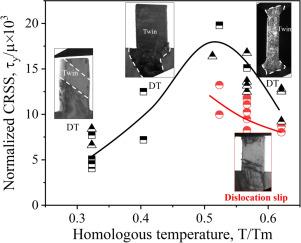Anomalous temperature effects on the twinning-dislocation transition in magnesium: in-situ quantitative thermal-mechanical investigations
IF 9.3
1区 材料科学
Q1 MATERIALS SCIENCE, MULTIDISCIPLINARY
引用次数: 0
Abstract
The effect of temperature on the plastic deformation mechanisms in submicron magnesium (Mg) single crystal is investigated by performing in-situ mechanical tests inside transmission electron microscope over the temperature range of 25 and 300 °C. The deformation in submicron Mg under compression along orientation transitions from twinning- to dislocation-dominated one over the temperature range of 210-250 °C. Below this temperature range, deformation is governed by deformation twins, while it is dominated by non-basal 〈a〉 dislocation slip above it. Under tension along [0001], due to the higher critical resolved shear stress (CRSS) for the pyramidal 〈c+a〉 dislocation slip (compared to that of deformation twins), no transition involving twins and pyramidal 〈c+a〉 dislocation slip occurs over the tested temperature range. Interestingly, an abnormal increase in the CRSS of deformation twinning with the temperature is observed, both under compression and tension. Critical experiments show that the observed anomalous temperature dependence is not caused by the stress required for twin boundary migration, which remains invariant with temperature, but may be attributed to the lack of heterogenous nucleation sites for twin nucleation at high temperatures. These findings provide new insights into the transition from twinning- to dislocation-dominated plasticity in Mg and its alloys at elevated temperatures. The methodology can be extended to investigate the high-temperature deformation behavior and mechanisms in other materials.


反常温度对镁中孪晶位错转变的影响:原位定量热力学研究
采用透射电子显微镜(TEM)对温度对亚微米Mg单晶塑性变形机制的影响进行了研究,温度范围为25℃和300℃。在210 ~ 250℃的温度范围内,沿[011¯0]取向压缩的亚微米Mg变形由孪晶为主转变为位错为主。在此温度范围以下,变形受{101¯2}变形孪晶控制,而在此温度范围以上则受非基底< a >位错滑移控制。在沿[0001]的拉伸下,由于锥体< c+a >位错滑移的临界分解剪应力(CRSS)较高(与{101¯2}变形孪晶相比),在测试温度范围内没有发生涉及孪晶和锥体< c+a >位错滑移的转变。有趣的是,在压缩和拉伸作用下,{101¯2}变形孪晶的CRSS均随温度的升高而异常升高。关键实验表明,观察到的异常温度依赖性不是由孪晶界迁移所需的应力引起的,而孪晶界迁移所需的应力随温度保持不变,而可能归因于高温下孪晶核的异质成核位点的缺乏。这些发现为镁及其合金在高温下从孪晶到位错主导的塑性转变提供了新的见解。该方法可以推广到研究其他材料的高温变形行为和机理。
本文章由计算机程序翻译,如有差异,请以英文原文为准。
求助全文
约1分钟内获得全文
求助全文
来源期刊

Acta Materialia
工程技术-材料科学:综合
CiteScore
16.10
自引率
8.50%
发文量
801
审稿时长
53 days
期刊介绍:
Acta Materialia serves as a platform for publishing full-length, original papers and commissioned overviews that contribute to a profound understanding of the correlation between the processing, structure, and properties of inorganic materials. The journal seeks papers with high impact potential or those that significantly propel the field forward. The scope includes the atomic and molecular arrangements, chemical and electronic structures, and microstructure of materials, focusing on their mechanical or functional behavior across all length scales, including nanostructures.
 求助内容:
求助内容: 应助结果提醒方式:
应助结果提醒方式:


